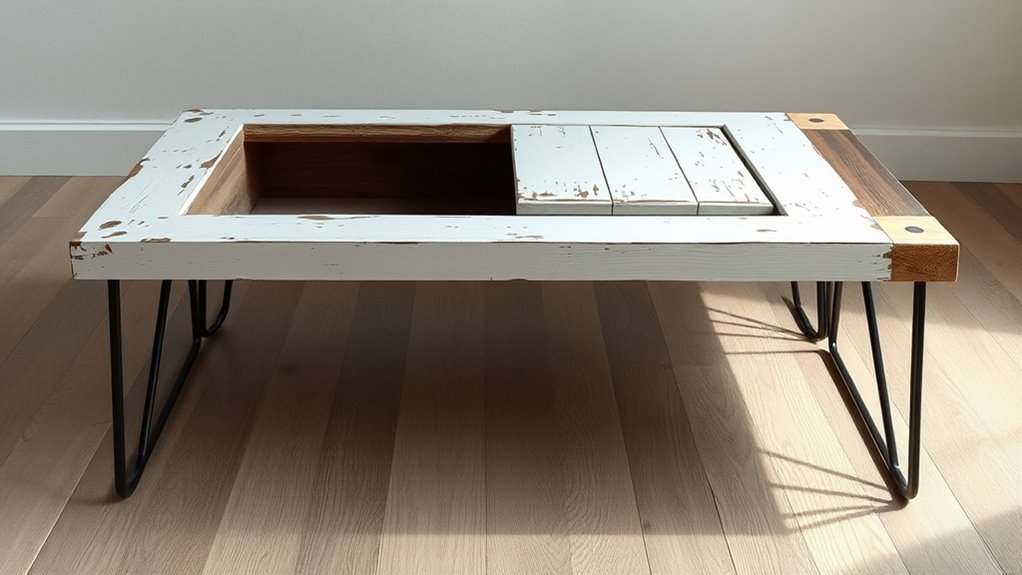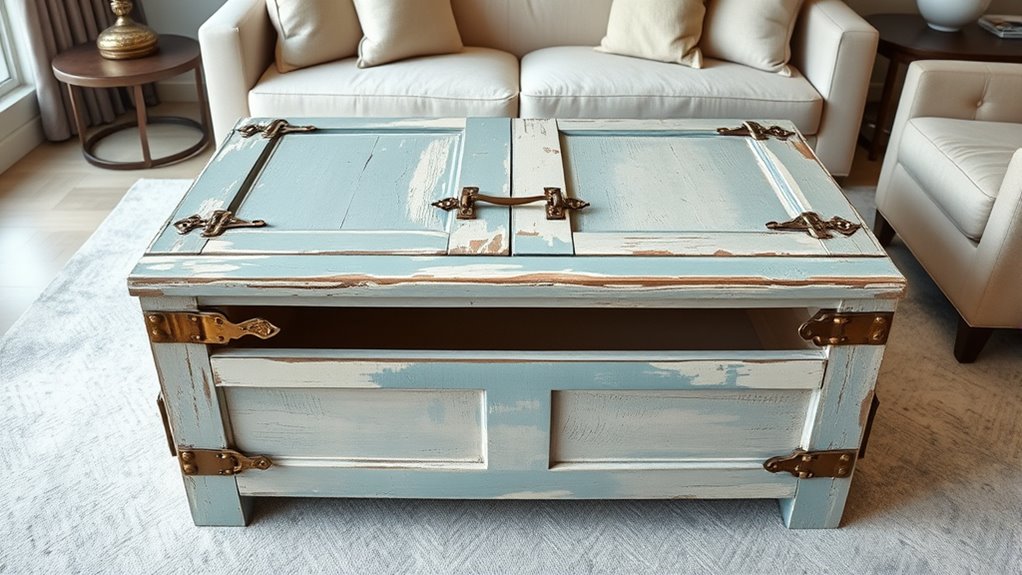Start by selecting a sturdy, vintage door and sanding it smooth to remove old paint or varnish. Attach stylish legs in your preferred material, ensuring stability, and finish the surface with stain or paint for a polished look. Incorporate a hidden storage compartment beneath a hinged panel for valuables or small items. Finish with a sealant for durability and matching hardware for a cohesive style. Keep going to discover step-by-step tips for creating your own chic, functional coffee table.
Key Takeaways
- Select a sturdy, vintage door and sand thoroughly for a smooth, attractive surface.
- Attach stylish legs at appropriate height for stability and aesthetic appeal.
- Finish with stain or paint, sealed with a protective topcoat for durability.
- Integrate a hinged or removable panel to create a hidden storage compartment.
- Ensure design harmony by matching hardware and color to your decor style.

Turning an old door into a coffee table is a creative way to repurpose furniture and add character to your living space. With a little DIY techniques, you can transform a piece of history into a functional and stylish centerpiece. This project not only saves money but also allows you to showcase your upcycling ideas, making your home uniquely yours. The process starts with selecting a sturdy, solid door—preferably one with interesting details or vintage charm. Once you’ve chosen the right door, you’ll need basic tools like a saw, drill, sandpaper, and paint or stain. Sanding is essential to smooth out rough edges and prepare the surface for finishing, revealing the beauty of the wood and removing any old paint or varnish.
Next, you’ll want to decide on the height of your coffee table. Typically, a height around 16 to 18 inches works well. To achieve this, you can attach sturdy wooden or metal legs to the underside of the door, using screws and a drill. For a sleek look, opt for legs that complement the style of the door—metal hairpin legs add a modern touch, while wooden legs can enhance a rustic vibe. Once the legs are securely attached, you can focus on finishing touches like staining or painting the door to match your decor. A clear sealant will protect the surface and give it a polished look.
What makes this project even more appealing is the hidden storage space you can incorporate. By adding a hinged panel or a removable section, you create a secret compartment perfect for storing magazines, remote controls, or other small items. This upcycling idea adds both functionality and a touch of surprise, making your coffee table more than just a surface—it’s a conversation starter. For extra durability, consider sealing the entire piece with a protective coat, especially if you plan to place drinks or food on it. When choosing a door, considering the contrast ratio of the surface can help ensure that the finish and color choices create the desired visual impact and harmony with your space.
Frequently Asked Questions
What Types of Doors Are Best Suited for This Project?
When choosing doors for your project, opt for solid wood or sturdy plywood, as they’re ideal for door restoration and can withstand the weight of added storage. Avoid hollow-core doors, which aren’t durable enough. Consider the door’s material selection to guarantee it matches your style and longevity. Flat, paneled, or reclaimed doors work beautifully, offering both aesthetic appeal and structural integrity for a custom coffee table with hidden storage.
How Do I Waterproof or Seal the Door Surface?
Imagine giving your project a shield of invisibility against spills and moisture. To achieve this, you should start with proper door sealing, ensuring all surfaces are prepped. Then, apply a waterproof finish designed for furniture, focusing on the top and edges. This combination creates a durable barrier, protecting your table from water damage while maintaining its chic look. With the right door sealing, your coffee table stays beautiful and functional longer.
Can I Add Wheels for Mobility?
You can definitely add wheels for door mobility by installing casters. First, choose sturdy casters suitable for furniture, then measure and mark the placement on the door’s underside. Use a drill and screws to securely attach the caster plates, ensuring smooth movement. Casters make your coffee table easy to move, so you can reposition it effortlessly while maintaining the door’s vintage charm and hidden storage functionality.
What Tools Are Required for the Conversion?
Think of your project as a journey where tools are your trusted compass. For door restoration and DIY furniture, you’ll need a saw to cut the door, a drill for hinges and wheels, a screwdriver, sandpaper or an electric sander, and paint or sealant. Safety gear like gloves and goggles is essential. With these tools, you’ll transform an old door into a stylish, functional coffee table with hidden storage.
How Much Weight Can the Hidden Storage Hold?
You might wonder how much weight the hidden storage can hold. Typically, the door’s weight capacity depends on its material and construction, but most sturdy doors can support around 50-100 pounds of storage capacity. To guarantee safety, avoid overloading it beyond the door weight limit. Always check the door’s specifications and reinforce the hinges if needed, so you can store items confidently without risking damage or accidents.
Conclusion
Transforming an old door into a chic coffee table not only gives new life to something forgotten but also sparks a sense of creativity and sustainability. Many believe that repurposing furniture can positively impact the environment and your home’s vibe. While some say it’s just a trend, others feel it’s a way to connect with history and craftsmanship. So, go ahead—embrace this project, and you might just discover that old things truly can become new treasures.









